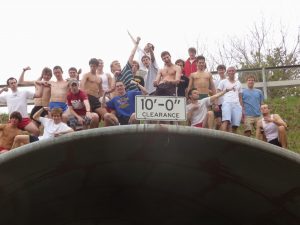Dear Distance Gurus: What Do You Think Of Hobbs Kessler Doubling Every Day?
LetsRun.com is launching a new coaching advice column - John Kellogg and Robert Johnson answer your questions
By Robert JohnsonIn the year 2024, there are all sorts of advice columns all over the internet, but we’ve never seen one for distance running. That is now changing. Back when LetsRun.com started in 2000, John Kellogg’s near-daily message board postings on training were a hallmark of LetsRun.com but he’s gone dark from the web for 20+ years. That’s changing now.
Each week, John and LetsRun.com co-founder Robert Johnson will be answering your questions in our “Dear Distance Gurus” column. John is most famous for transforming Weldon Johnson from a college hack with a 30:06 10,000 PR to a near-Olympian who ran 28:06 and finished 4th at USAs twice. Robert and John then used John’s training methods to win zero Ivy League XC titles totally dominate the Ivy League in indoor and outdoor track during a 10-year coaching stint at Cornell University where they captured 13 Ivy League track titles.
Now that the statute of limitations from their Cornell tenure is over as almost everyone they coached is retired, they will be handing out their advice on LRC. If you have a question for a future column, email it to DDG@letsrun.com.
Dear Distance Gurus (DDG): Recently, Hobbs Kessler told letsrun.com that he bonks on all runs longer than 7-8 miles. If he was doing 10-12, he’d bonk and just have to grind it out. He felt like his stimulus to fatigue ratio was off as he was getting tired out on the easy days and not getting much stimulus, so now he pretty much doubles every day (6 days a week with one day off) to get the volume up but never runs more than 50 minutes (7 miles) at a time. His longest normal run is 7 miles and he’s gotten rid of most long runs but has done a few 12 milers. What do you think of this? It sounds like he feels much fresher and can do more quality when he does run/lift.
 Robert: Great question. I remember back in the day talking to John about a lot of the concepts brought up in your question. I think we should really break your question down into several different ones. The biggest questions I see are as follows.
Robert: Great question. I remember back in the day talking to John about a lot of the concepts brought up in your question. I think we should really break your question down into several different ones. The biggest questions I see are as follows.
- Let’s say someone is running 70 miles a week. Most assume it’s way better to run 10 miles once a day than five miles twice a day. So is a 10 or 12 mile run better than 5 and 5 or 5 and 7? What do you gain and lose from breaking it up?
- Should Kessler try to get that 50 minute run up to an hour? John, I remember you used to talk to me about how you felt there was something magical about hitting 60 minutes.
- Do milers need long runs? I remember when we started at Cornell we didn’t have a lot of long runs on the schedule and John told me it wasn’t really needed in-season for the college track distances.
- What do you think of taking a day off every single week? Tons of people pride themselves on their weekly totals, but the BYU guys take a day off and do pretty well and Paula Radcliffe famously took one off every other week.
All right. Let’s try to address the first two questions today. We’ll probably answer #3 and #4 in later columns.
#1 Let’s say someone is running 70 miles a week. Most assume it’s way better to run 10 miles once a day than five miles twice a day. So is a 10 or 12 mile run better than 5 and 5 or 5 and 7? What do you gain and lose from breaking it up?
JK: The plus side with the long run is that glycogen depletion occurs in the slow twitch muscle fibers and in the quick twitch units, resulting in the fast twitch fibers becoming more oxidative and assuming some of the aerobic properties of their slow twitch counterparts. As you get fitter and more inured to long runs, you’ll of course need to do a little faster pace (or do a pace pickup or some quick strides near the end of the long runs) to invoke some aerobic pressure and actually recruit some of the muscle fibers which are farther along the spectrum toward the fast twitch side. Just continuing to jog your long runs won’t be of much benefit in helping fast twitch fibers take on more aerobic properties. Also note that you won’t improve your speed by depleting your fast twitch fibers on long runs. You have to run fast to improve speed. Aerobic running – even high-end aerobic running – won’t get the job done there.
The down side of long runs for some runners is that their stride mechanics may involve more vertical oscillation (“springy” strides rather than “gliding” strides), which could make these runners more prone to connective tissue stress. Even if this stress doesn’t increase injury risk, it still translates into metabolic stress which requires more recovery time and/or interferes with the amount of time spent working at race pace.
The upside of breaking a longer run into two medium length runs spaced out during the day comes from the reduced recovery time between outings, which expedites the process of adaptation – i.e., you get in shape quicker! The same principle is in play when you do two moderate intensity workouts in a day (the so-called “double threshold” method) – provided you don’t go too hard or do them too often (like we all did in college in my time). In a nutshell, for many middle distance runners who have “bouncy” stride mechanics, doing doubles rather than long singles might be the better option.
#2 Should Kessler try to get that 50 minute run up to an hour? John, I remember you used to talk to me about how you felt there was something magical about hitting 60 minutes.
JK: There does seem to be some non-linear boost from doing 60-65 minutes for regular runs vs. doing 50-ish minutes. After all these decades, I still don’t know if it’s a physical process or if it’s just time management (people tend to organize in one-hour or half-hour blocks, and this might assist in managing overall daily stress). I’m of the belief that actual physical changes take place in non-linear fashions. Uhhh … sleep cycles? Meal frequency? Of course bodies have rhythms and respond favorably in regular patterns. It ought to be well known that 60-ish miles per week is a “sweet spot” for making significant improvements in fitness. A lot of runners never discover it, but 90-ish miles per week is far more significant if you can do that mileage safely and at speeds which actually invoke enough aerobic pressure to provide a stimulus. Far be it for me to tell any individual that he has to do an hour instead of 50 minutes, assuming that runner has discovered through trial and error that more is lost than gained by forcing out those extra 10 minutes.
When I finally met Arthur Lydiard in 1993, I asked him about the general effort he and his protégés were using during base training, and he said, “Well, we weren’t jogging!” To that I replied, “Long slow distance is good, but it’s not nearly as good as long fast distance!” And he said, “John’s got it!” So the point is that you should make an honest effort to get those easy runs up to at least an hour, but if you have to sacrifice too much to do it (whether in terms of injury risk or a pace which will have a training effect, etc.), you might be better off running a few minutes less. Give the longer runs a chance, but in the end, you’ll have to find your own sweet spot. Bro science definitely has its place.
Robert: Well that’s enough for the first column. We’ve got plenty of more stuff to get to for future columns – questions #3 and #4 plus an entirely new topic we need to bank for an additional column as well – what pace should people run their recovery days? Weldon Johnson and the entire Cornell team was famous for going super slow on their easy days and yet John just praised the concept of running the easy days quicker.
Talk about this article on our world-famous messageboard.
Got a question? Email us DDG@letsrun.com.

